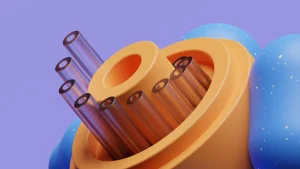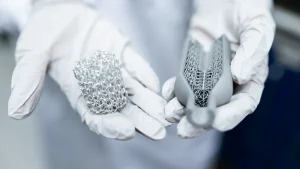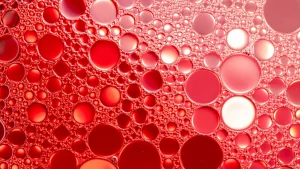
CVD SiC coating has transformed heating element performance by delivering unmatched thermal stability and resistance to wear. Its application enhances energy efficiency and extends the lifespan of industrial components. Exploring advancements in the sic coating market reveals innovations that address modern challenges. The cvd sic coating heating element continues to redefine industrial standards in 2025.
要点
- CVD SiC coatings help heating elements work better and last longer.
- Mixing ALD and CVD methods makes coatings more exact and cheaper.
- Tiny tech in SiC coatings makes heat move faster and stay strong.
Advancements in CVD SiC Coating Technology

Hybrid ALD-CVD Techniques for Enhanced Coating Efficiency
Hybrid ALD-CVD techniques have emerged as a game-changer in the field of silicon carbide coatings. By combining Atomic Layer Deposition (ALD) with Chemical Vapor Deposition (CVD), manufacturers achieve precise control over coating thickness and uniformity. This hybrid approach enhances the efficiency of the deposition process while reducing material waste. It also enables the creation of ultra-thin, defect-free layers that improve the performance of the cvd sic coating heating element. Industries now benefit from faster production cycles and lower operational costs, making this technique a preferred choice for high-performance applications.
Integration of Nanotechnology in SiC Coatings
Nanotechnology has introduced a new dimension to silicon carbide coatings. By incorporating nanoparticles into the coating matrix, engineers enhance properties such as thermal conductivity, hardness, and resistance to oxidation. These advancements allow the cvd sic coating heating element to operate efficiently under extreme conditions. Nanostructured coatings also exhibit superior adhesion to substrates, reducing the risk of delamination. This innovation has opened doors for applications in sectors requiring precision and reliability, such as aerospace and semiconductor manufacturing.
Development of SIGRAFINE Advanced SiC Coatings
SIGRAFINE advanced SiC coatings represent a significant leap in coating technology. These coatings offer exceptional resistance to chemical corrosion and thermal shock. Their unique composition ensures consistent performance even in the harshest environments. SIGRAFINE coatings have been optimized for use in cvd sic coating heating element systems, delivering unmatched durability and energy efficiency. Their development reflects the industry’s commitment to pushing the boundaries of material science to meet evolving industrial demands.
Applications and Benefits of CVD SiC Coating Heating Element

Improved Thermal Conductivity and Energy Efficiency
CVD SiC coatings significantly enhance the thermal conductivity of heating elements. This improvement allows for faster heat transfer, reducing energy consumption in industrial processes. The uniformity of the coating ensures consistent heat distribution, minimizing energy losses. Industries utilizing the cvd sic coating heating element report substantial savings in operational costs due to its energy-efficient performance. These coatings also enable heating elements to operate at higher temperatures without compromising efficiency, making them ideal for demanding applications.
ヒント Improved thermal conductivity not only boosts efficiency but also reduces the environmental impact of energy-intensive processes.
Enhanced Durability and Longevity of Heating Elements
について durability of heating elements coated with CVD SiC has set new benchmarks in industrial applications. These coatings provide exceptional resistance to wear, oxidation, and chemical corrosion. As a result, the cvd sic coating heating element exhibits a longer operational lifespan compared to uncoated alternatives. This durability reduces the frequency of maintenance and replacement, leading to lower downtime and operational costs. The robust nature of these coatings ensures reliable performance even in harsh environments, such as high-temperature furnaces or corrosive chemical reactors.
Role in High-Precision Industrial Applications
CVD SiC coatings play a critical role in industries requiring high precision and reliability. Their ability to maintain structural integrity under extreme conditions makes them indispensable in sectors like aerospace, semiconductors, and advanced manufacturing. The cvd sic coating heating element ensures consistent performance, which is crucial for processes demanding tight tolerances. For example, semiconductor fabrication benefits from the coating’s ability to withstand high temperatures and maintain uniform heating, ensuring product quality and process efficiency.
注: The versatility of these coatings makes them a preferred choice for cutting-edge technologies and emerging industrial applications.
Market Trends and Growth Drivers
Increasing Demand in Semiconductor and Electronics Industries
The semiconductor and electronics industries have witnessed a surge in demand for advanced materials. CVD SiC coatings have become essential in these sectors due to their ability to withstand high temperatures and maintain precision. Manufacturers rely on the cvd sic coating heating element to ensure consistent performance in processes like wafer fabrication and microchip production. The growing adoption of 5G technology and artificial intelligence has further fueled the need for reliable heating elements. These coatings enable devices to operate efficiently, even under extreme conditions, making them indispensable in modern electronics.
Adoption in Renewable Energy and Green Technologies
Renewable energy systems require materials that can endure harsh environments while maintaining efficiency. CVD SiC coatings have emerged as a preferred choice for heating elements in solar panels, wind turbines, and energy storage systems. Their exceptional thermal conductivity and durability contribute to improved energy conversion rates. The cvd sic coating heating element plays a pivotal role in reducing energy losses, aligning with global efforts to adopt sustainable practices. As green technologies continue to expand, the demand for these coatings is expected to grow significantly.
Growth in Automotive and Aerospace Sectors
The automotive and aerospace sectors have increasingly integrated CVD SiC coatings into their designs. Electric vehicles benefit from these coatings in battery management systems and heating components, enhancing energy efficiency and safety. In aerospace, the cvd sic coating heating element ensures reliable performance in high-temperature environments, such as jet engines and spacecraft. The push for lightweight, durable materials has driven innovation in these industries, positioning CVD SiC coatings as a critical solution for future advancements.
Challenges and Opportunities
Addressing High Costs and Scalability Issues
CVD SiC coatings offer exceptional performance, but their high production costs remain a significant challenge. The complex deposition process and the need for specialized equipment contribute to these expenses. Scaling up production for large-scale industrial applications adds another layer of difficulty. Manufacturers must balance quality with cost-effectiveness to meet market demands.
Insight: Collaborative efforts between research institutions and industry players can drive innovation in cost-reduction strategies. For example, optimizing deposition parameters or developing alternative precursor materials could lower expenses.
To address scalability, companies are exploring modular production systems. These systems allow for incremental capacity expansion, reducing upfront investment risks. Additionally, automation in CVD processes can enhance efficiency and minimize labor costs.
Opportunities in Emerging Markets and Industries
Emerging markets present untapped potential for CVD SiC coatings. Rapid industrialization in regions like Southeast Asia and South America has increased demand for advanced materials. Industries such as electronics, renewable energy, and automotive are expanding in these areas, creating new opportunities for growth.
ヒント Companies entering these markets should focus on localized production and partnerships. This approach can help reduce logistical challenges and build stronger customer relationships.
Innovative applications in industries like medical devices and quantum computing also offer promising avenues. The unique properties of CVD SiC coatings make them suitable for cutting-edge technologies requiring precision and durability.
Advancements in Sustainable and Eco-Friendly CVD Processes
Sustainability has become a priority for the CVD SiC coating industry. Traditional processes often involve hazardous chemicals and high energy consumption. To address these concerns, researchers are developing eco-friendly alternatives.
- Low-temperature deposition techniques reduce energy usage.
- Green precursors minimize environmental impact.
- Recycling initiatives recover and reuse materials from the coating process.
注: Adopting sustainable practices not only benefits the environment but also enhances a company’s reputation in an increasingly eco-conscious market.
These advancements align with global sustainability goals, positioning CVD SiC coatings as a forward-thinking solution for modern industries.
Advancements in CVD SiC coating technology have revolutionized heating elements by enhancing efficiency, durability, and precision. These innovations address industrial challenges while unlocking new applications. The industry’s future promises growth through sustainable practices, cost-effective solutions, and expanding markets. Continued innovation will solidify CVD SiC coatings as a cornerstone of modern industrial advancements.






